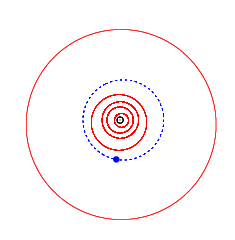Astronomy:9902 Kirkpatrick
 Orbit of Kirkpatrick (blue), with the inner planets and Jupiter (outermost) | |
| Discovery [1] | |
|---|---|
| Discovered by | P. G. Comba |
| Discovery site | Prescott Obs. |
| Discovery date | 3 July 1997 |
| Designations | |
| (9902) Kirkpatrick | |
| Named after | Ralph Kirkpatrick (musician, musicologist)[2] |
| 1997 NY · 1988 XS4 1994 RK29 · 1996 EJ16 | |
| Minor planet category | main-belt [1][3] · (inner) Flora |
| Orbital characteristics [1] | |
| Epoch 4 September 2017 (JD 2458000.5) | |
| Uncertainty parameter 0 | |
| Observation arc | 28.48 yr (10,401 days) |
| |{{{apsis}}}|helion}} | 2.3935 AU |
| |{{{apsis}}}|helion}} | 2.0276 AU |
| 2.2105 AU | |
| Eccentricity | 0.0828 |
| Orbital period | 3.29 yr (1,200 days) |
| Mean anomaly | 254.92° |
| Mean motion | 0° 17m 59.64s / day |
| Inclination | 5.3167° |
| Longitude of ascending node | 274.37° |
| 176.19° | |
| Physical characteristics | |
| Dimensions | 3.611±0.166 km[4] 17.8 km[5] |
| Geometric albedo | 0.179±0.022[4] |
| Absolute magnitude (H) | 14.4[1] |
9902 Kirkpatrick, provisional designation 1997 NY, is a Florian asteroid from the inner regions of the asteroid belt, approximately 4 kilometers in diameter. The asteroid was discovered on 3 July 1997, by American amateur astronomer Paul Comba at Prescott Observatory in Arizona, United States, and named after American musician Ralph Kirkpatrick.[3]
Orbit and classification
Kirkpatrick is a member of the Flora family. It orbits the Sun in the inner main-belt at a distance of 2.0–2.4 AU once every 3 years and 3 months (1,200 days). Its orbit has an eccentricity of 0.08 and an inclination of 5° with respect to the ecliptic.[1] It was first identified as 1988 XS4 at El Leoncito in 1988, extending the asteroid's observation arc by 9 years prior to its official discovery at Prescott.[3]
Physical characteristics
Rotation period
As of 2017, the asteroid's rotation period and shape remain unknown.[6]
Diameter and albedo
According to the surveys carried out by the Infrared Astronomical Satellite IRAS and NASA's Wide-field Infrared Survey Explorer with its subsequent NEOWISE mission, Kirkpatrick measures 17.8 and 3.611 kilometers in diameter, respectively.[4][5] WISE/NEOWISE also gives an albedo of 0.179 for the body's surface.[4] It has an absolute magnitude of 14.4.[1]
Naming
This minor planet was named after Ralph Kirkpatrick (1911–1984), an American musician, musicologist and harpsichordist. He has written a biography of Domenico Scarlatti and published a chronological catalog of his keyboard sonatas (also see 6480 Scarlatti). Kirkpatrick studied 17th and 18th century performance practices in chamber music and gave concerts playing the works by Scarlatti and Bach (also see 1814 Bach).[2] The official naming citation was published by the Minor Planet Center on 2 April 1999 (M.P.C. 34356).[7]
References
- ↑ 1.0 1.1 1.2 1.3 1.4 1.5 "JPL Small-Body Database Browser: 9902 Kirkpatrick (1997 NY)". Jet Propulsion Laboratory. https://ssd.jpl.nasa.gov/sbdb.cgi?sstr=2009902.
- ↑ 2.0 2.1 Schmadel, Lutz D. (2007). "(9902) Kirkpatrick". Dictionary of Minor Planet Names – (9902) Kirkpatrick. Springer Berlin Heidelberg. p. 712. doi:10.1007/978-3-540-29925-7_7741. ISBN 978-3-540-00238-3.
- ↑ 3.0 3.1 3.2 "9902 Kirkpatrick (1997 NY)". Minor Planet Center. https://www.minorplanetcenter.net/db_search/show_object?object_id=9902.
- ↑ 4.0 4.1 4.2 4.3 Masiero, Joseph R.; Mainzer, A. K.; Grav, T.; Bauer, J. M.; Cutri, R. M.; Dailey, J. et al. (November 2011). "Main Belt Asteroids with WISE/NEOWISE. I. Preliminary Albedos and Diameters". The Astrophysical Journal 741 (2): 20. doi:10.1088/0004-637X/741/2/68. Bibcode: 2011ApJ...741...68M. http://adsabs.harvard.edu/cgi-bin/bib_query?bibcode=2011ApJ...741...68M. Retrieved 17 March 2017.
- ↑ 5.0 5.1 Tedesco E.F.; Noah P.V.. "The supplemental IRAS minor planet survey (SIMPS)". http://www.iop.org/EJ/article/1538-3881/123/2/1056/FP206.txt?request-id=ZkkEm1jA3BGTV3i82wi7Kg.
- ↑ "LCDB Data for (9902) Kirkpatrick". Asteroid Lightcurve Database (LCDB). http://www.minorplanet.info/PHP/generateOneAsteroidInfo.php?AstInfo=9902%7CKirkpatrick.
- ↑ "MPC/MPO/MPS Archive". Minor Planet Center. https://www.minorplanetcenter.net/iau/ECS/MPCArchive/MPCArchive_TBL.html.
External links
- Asteroid Lightcurve Database (LCDB), query form (info )
- Dictionary of Minor Planet Names, Google books
- Asteroids and comets rotation curves, CdR – Observatoire de Genève, Raoul Behrend
- Discovery Circumstances: Numbered Minor Planets (5001)-(10000) – Minor Planet Center
- 9902 Kirkpatrick at AstDyS-2, Asteroids—Dynamic Site
- 9902 Kirkpatrick at the JPL Small-Body Database
 |

